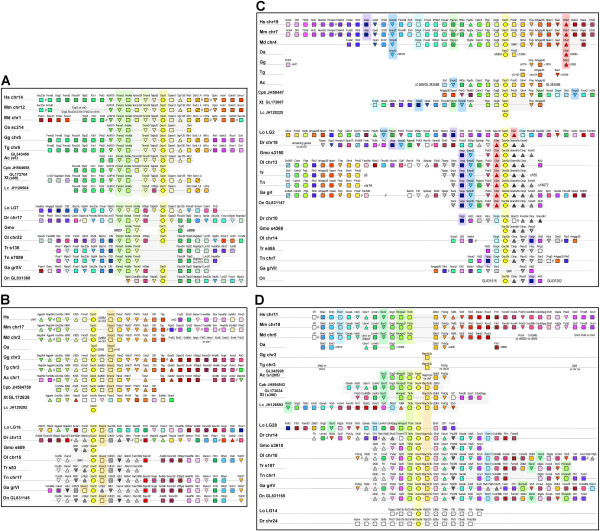Figure 3.

Organization of gnathostome Dact genomic loci. Genomic environment of the Dact1 (A), Dact2 (B), Dact3 (C) and Dact4 (D) genes. Shape code: circle - Dact gene; square - gene with paralogs also associated with Dact genes; triangle, tip down - unique gene without any paralogs; triangle, tip up - gene with paralogs not associated with Dact loci. Shape infill: yellow - Dact genes; other colours - genes associated with tetrapod and teleost Dact loci. A rainbow color scheme was applied to the human locus in the case of Dact1/3 and 4; in the case of Dact2, the mammalian loci are fragmented, hence the rainbow color scheme was applied to the better preserved chicken locus. Orthologous genes are displayed in the same color. Gray infill - genes associated with teleost dact genes only; striped pattern - genes associated with Dact loci in teleosts, non-mammalian tetrapods and the opossum, but dispersed in placental mammals. The color of the stripes corresponds to that of the neighboring filled-in shape in teleosts. A diagonal bar in the boxes representing Six genes indicates the presence of several Six paralogs at this site. Underlying shading: yellow shading - Dact genes; other colours - core genes associated with a particular Dact gene; grey shading - genes within 1 Mb distance from Dact genes. Double slash - genes or gene groups separated by more than 3 Mb. Species names (abbreviations: see Additional file 1) and genomic localization of genes are indicated on the left side of the figures if the loci are continuous. If genes are distributed over several scaffolds or chromosomes, the names of these sites are shown next to the corresponding genomic fragment. Note that the same genes, albeit not always in the same order, are associated with a particular Dact ortholog; also note the similarity of the teleost dact3a and 3b loci, further indicating their common origin from an ancestral dact3 gene during 3R. This supports our assignment of gnathostome Dact sequences to four paralog groups. A number of genes are only found in conjunction with teleost dact genes, suggesting that they have invaded the locus after the two round of genome duplication shared by sarcopterygians and actinopterygians, but before the third, teleost-specific genome duplication.
